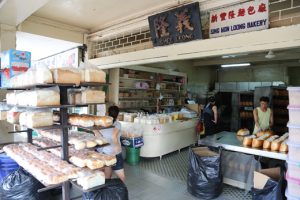Memo #264
By Sharon Lim – sharon.lim [at] alumni.ubc.ca
In 2010, Old Places was the highest-rated documentary on Singaporean television. This speaks to the appeal of Royston Tan’s documentary—structured around the reminiscences of ordinary Singaporeans, with on-screen images of places and material objects that they feel are slowly disappearing from the Singaporean cityscape. Narrators share their memories of things that matter to them, reflecting on sites of memory and the universal quality of nostalgia for days gone by (with local foods and drinks standing in for Marcel Proust’s famous madeleine). For instance, one speaker compares the “very oily” mass-produced breads with the “lasting taste” imparted from the breads of Ghee Leong Bakery, one of few remaining traditional bakeries in Singapore.
The customs, traditional trades and other seemingly ephemeral elements of a particular culture are integral to that culture’s sense of collective heritage and identity. But the landscape of Singapore has been changing rapidly since the 1990s. The Singapore government’s aspiration for “global city” status has made the nation a global economic hub, but not without a certain price. The infrastructural changes that have transformed the urban environment have also made a discernible impact on ICH. The “demolition” of ICH has occurred subtly and gradually, which means that people may not even notice that important aspects of the culture are vanishing.
While the state has long been committed to the conservatorship of Singapore’s national treasures—that is to say the material artefacts displayed in its renowned museums—we must now recognize that the category of “national treasure” needs to be broadened to include priceless cultural elements that cannot simply be stored behind a glass case. The preservation of such ICH requires the input and involvement of different stakeholders in order to determine what constitutes ICH in Singapore and how to best proceed in protecting our shared heritage.
Members of the public should take a pro-active role in expressing what aspects of culture mean most to them. Otherwise, there is a risk that they will awake one day to find that these unique aspects of Singapore’s identity—which is what keeps citizens rooted to the nation—have been lost forever.
About the Author:
Sharon Lim is a University of British Columbia student affiliated with the Institute of Asian Research. She is particularly interested in cultural policy, with a specific focus on identity construction and museums.
-

Ghee Leong Bakery in Whampoa (photo credit: Jimmy Oh)
Links:
- Old Places (A Documentary by Royston Tan), 2010
- “SE Asians Debate ‘Intangible’ Heritage,” Wall Street Journal, February 2012
- “A History of Singapore in 50 Objects,” The Straits Times
- Gaik Cheng Khoo, “Of Diminishing Memories and Old Places: Singaporean Films and the Work of Archiving Landscape,” Concentric: Literary and Cultural Studies, March 2013
Related Memos:
See our other memos on Singapore.
Comments are closed, but trackbacks and pingbacks are open.